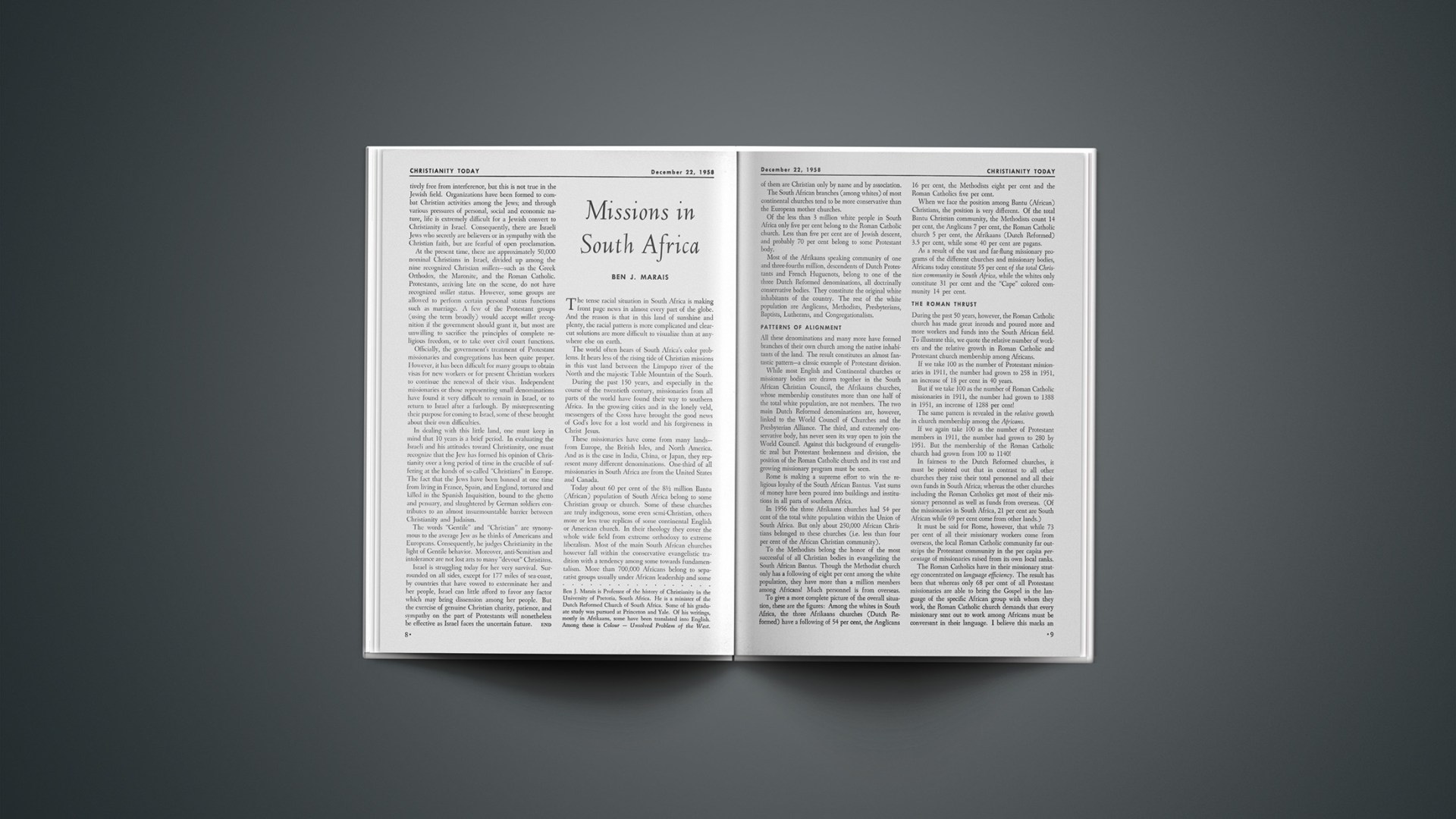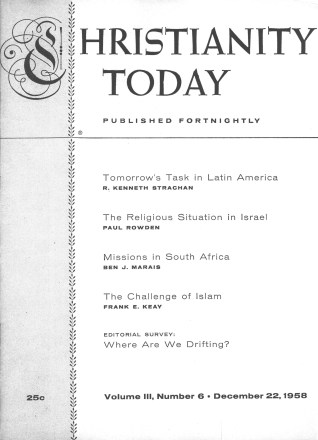The tense racial situation in South Africa is making front page news in almost every part of the globe. And the reason is that in this land of sunshine and plenty, the racial pattern is more complicated and clear-cut solutions are more difficult to visualize than at anywhere else on earth.
The world often hears of South Africa’s color problems. It hears less of the rising tide of Christian missions in this vast land between the Limpopo river of the North and the majestic Table Mountain of the South.
During the past 150 years, and especially in the course of the twentieth century, missionaries from all parts of the world have found their way to southern Africa. In the growing cities and in the lonely veld, messengers of the Cross have brought the good news of God’s love for a lost world and his forgiveness in Christ Jesus.
These missionaries have come from many lands—from Europe, the British Isles, and North America. And as is the case in India, China, or Japan, they represent many different denominations. One-third of all missionaries in South Africa are from the United States and Canada.
Today about 60 per cent of the 8½ million Bantu (African) population of South Africa belong to some Christian group or church. Some of these churches are truly indigenous, some even semi-Christian, others more or less true replicas of some continental English or American church. In their theology they cover the whole wide field from extreme orthodoxy to extreme liberalism. Most of the main South African churches however fall within the conservative evangelistic tradition with a tendency among some towards fundamentalism. More than 700,000 Africans belong to separatist groups usually under African leadership and some of them are Christian only by name and by association.
The South African branches (among whites) of most continental churches tend to be more conservative than the European mother churches.
Of the less than 3 million white people in South Africa only five per cent belong to the Roman Catholic church. Less than five per cent are of Jewish descent, and probably 70 per cent belong to some Protestant body.
Most of the Afrikaans speaking community of one and three-fourths million, descendents of Dutch Protestants and French Huguenots, belong to one of the three Dutch Reformed denominations, all doctrinally conservative bodies. They constitute the original white inhabitants of the country. The rest of the white population are Anglicans, Methodists, Presbyterians, Baptists, Lutherans, and Congregationalists.
Patterns Of Alignment
All these denominations and many more have formed branches of their own church among the native inhabitants of the land. The result constitutes an almost fantastic pattern—a classic example of Protestant division.
While most English and Continental churches or missionary bodies are drawn together in the South African Christian Council, the Afrikaans churches, whose membership constitutes more than one half of the total white population, are not members. The two main Dutch Reformed denominations are, however, linked to the World Council of Churches and the Presbyterian Alliance. The third, and extremely conservative body, has never seen its way open to join the World Council. Against this background of evangelistic zeal but Protestant brokenness and division, the position of the Roman Catholic church and its vast and growing missionary program must be seen.
Rome is making a supreme effort to win the religious loyalty of the South African Bantus. Vast sums of money have been poured into buildings and institutions in all parts of southern Africa.
In 1956 the three Afrikaans churches had 54 per cent of the total white population within the Union of South Africa. But only about 250,000 African Christians belonged to these churches (i.e. less than four per cent of the African Christian community).
To the Methodists belong the honor of the most successful of all Christian bodies in evangelizing the South African Bantus. Though the Methodist church only has a following of eight per cent among the white population, they have more than a million members among Africans! Much personnel is from overseas.
To give a more complete picture of the overall situation, these are the figures: Among the whites in South Africa, the three Afrikaans churches (Dutch Reformed) have a following of 54 per cent, the Anglicans 16 per cent, the Methodists eight per cent and the Roman Catholics five per cent.
When we face the position among Bantu (African) Christians, the position is very different. Of the total Bantu Christian community, the Methodists count 14 per cent, the Anglicans 7 per cent, the Roman Catholic church 5 per cent, the Afrikaans (Dutch Reformed) 3.5 per cent, while some 40 per cent are pagans.
As a result of the vast and far-flung missionary programs of the different churches and missionary bodies, Africans today constitute 55 per cent of the total Christian community in South Africa, while the whites only constitute 31 per cent and the “Cape” colored community 14 per cent.
The Roman Thrust
During the past 50 years, however, the Roman Catholic church has made great inroads and poured more and more workers and funds into the South African field. To illustrate this, we quote the relative number of workers and the relative growth in Roman Catholic and Protestant church membership among Africans.
If we take 100 as the number of Protestant missionaries in 1911, the number had grown to 258 in 1951, an increase of 18 per cent in 40 years.
But if we take 100 as the number of Roman Catholic missionaries in 1911, the number had grown to 1388 in 1951, an increase of 1288 per cent!
The same pattern is revealed in the relative growth in church membership among the Africans.
If we again take 100 as the number of Protestant members in 1911, the number had grown to 280 by 1951. But the membership of the Roman Catholic church had grown from 100 to 1140!
In fairness to the Dutch Reformed churches, it must be pointed out that in contrast to all other churches they raise their total personnel and all their own funds in South Africa; whereas the other churches including the Roman Catholics get most of their missionary personnel as well as funds from overseas. (Of the missionaries in South Africa, 21 per cent are South African while 69 per cent come from other lands.)
It must be said for Rome, however, that while 73 per cent of all their missionary workers come from overseas, the local Roman Catholic community far outstrips the Protestant community in the per capita percentage of missionaries raised from its own local ranks.
The Roman Catholics have in their missionary strategy concentrated on language efficiency. The result has been that whereas only 68 per cent of all Protestant missionaries are able to bring the Gospel in the language of the specific African group with whom they work, the Roman Catholic church demands that every missionary sent out to work among Africans must be conversant in their language. I believe this marks an extremely important factor. Protestants have taken note of it, however. We realize that work done through interpreters can not reach the roots of life and bring the Gospel home in the most effective way.
If we want to appreciate the overall picture of missions in this part of the world, two other factors must be considered: (1) the position of Basutuland, and (2) the remarkable resurgence of missionary activity in the Dutch Reformed churches.
As far as Basutuland, the British Protectorate centering on the fastnesses of the great Drakensberg range (Dragon Mountain), is concerned, we must point out that geographically it is the heart-land of South Africa. Strategically it is extremely important from a missionary point of view. From the Protestant side, the French have concentrated on this area for about 100 years, and they have made steady progress. But during the last decades Rome has made great headway in Basutuland, and through educational and other channels it is steadily obtaining a stranglehold on this people, although the French Protestants probably still hold a slight numerical advantage. As the situation develops there is real concern among evangelicals that the French may not be able to hold their own. This will be a great setback for the evangelical cause in southern Africa.
The other important factor is the new missionary spirit in the Dutch Reformed group of churches. The main branch (The Nederduitse Gereformeerde Kerk) has always had a strong missionary program, but until a short while ago the other two Dutch Reformed churches had no missions. The situation is changing rapidly as both these denominations and especially the Gereformeerde Kerk enter the South African field.
All these churches are working in the closest cooperation with the government (many think too close); and they are starting out on new ventures in evangelism and hospitalization especially. The changing picture reveals the following facts:
Whereas the main Dutch Reformed body, die Nederduitse Gereformeerde Kerk, had 25 hospitals in all of Africa in 1956, 20 new hospitals have been opened since or are being built or planned for the Union of South Africa alone.
As far as manpower is concerned, there has been a real upsurge. Many young men, among them some of our best trained theologians, have become missionaries. Every month stations or preaching posts are opened.
The Dutch Reformed church has also launched a fund for literature for the African. The target is 3 million pounds (about 9 million dollars), and already close to one million dollars is in hand.
There is no cause for alarm providing Protestant churches perform their duty. Hopeful signs exist that evangelicals are facing up to the challenge of the hour.
END
Ben J. Marais is Professor of the history of Christianity in the University of Pretoria, South Africa. He is a minister of the Dutch Reformed Church of South Africa. Some of his graduate study was pursued at Princeton and Yale. Of his writings, mostly in Afrikaans, some have been translated into English. Among these is Colour—Unsolved Problem of the West.










